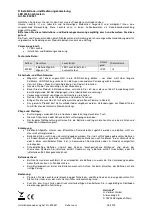
Installation-, Operating-, Maintenance-Manual, Spare part List
MAK10
AGT-PSG GmbH & Co.KG
Errors and printing mistakes excepted
Page 39
Translation - Manual MAK10 Rev. 11/2017
Functional Characteristics of the Refrigerant Circuit
Depending on operating condition, the
refrigerant compressor
compresses the vaporous refrigerant from the
inlet pressure of approximately 210kPa (=2,1bar) to the condensation pressure of 800-1700kPa (=8-17bar).
The vaporous refrigerant is liquefied by cooling in the subsequent
refrigerant condenser
. The fluid refrigerant is
passed through the
refrigerant dryer
to the
flue damper
.
The fluid refrigerant is expanded by the
flue damper
from high pressure (condensation pressure) 1100kPa to low
pressure (evaporation pressure) 210kPa. This expanded and fluid refrigerant flows through the
evaporator
of the
heat-exchanger
. By energy input of the heat-exchanger the fluid refrigerant evaporates and cools down the
passed through sample gas to a temperature of +3°C. Over the
steam dome
the
refrigerant compressor
sucks again the vaporous refrigerant.
Over the
power regulator
the sample gas conditioner performs a self-adjustment to alternating gas flows, inlet
temperatures and dew points. With a by-pass from the pressure- to the suction-site the pressure- and
temperature-controlled
power regulator
keeps the sample gas chilling temperature constant to +3°C.
The
temperature control unit
monitors the ambient and the dew point temperature but it does not access the
power regulation. It provides an alarm at unacceptable exceeding or undercut of temperature as well as at
exceeding service intervals. It logs all malfunctions of the cooler.












































